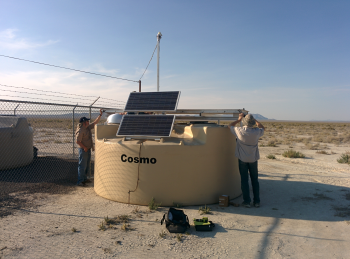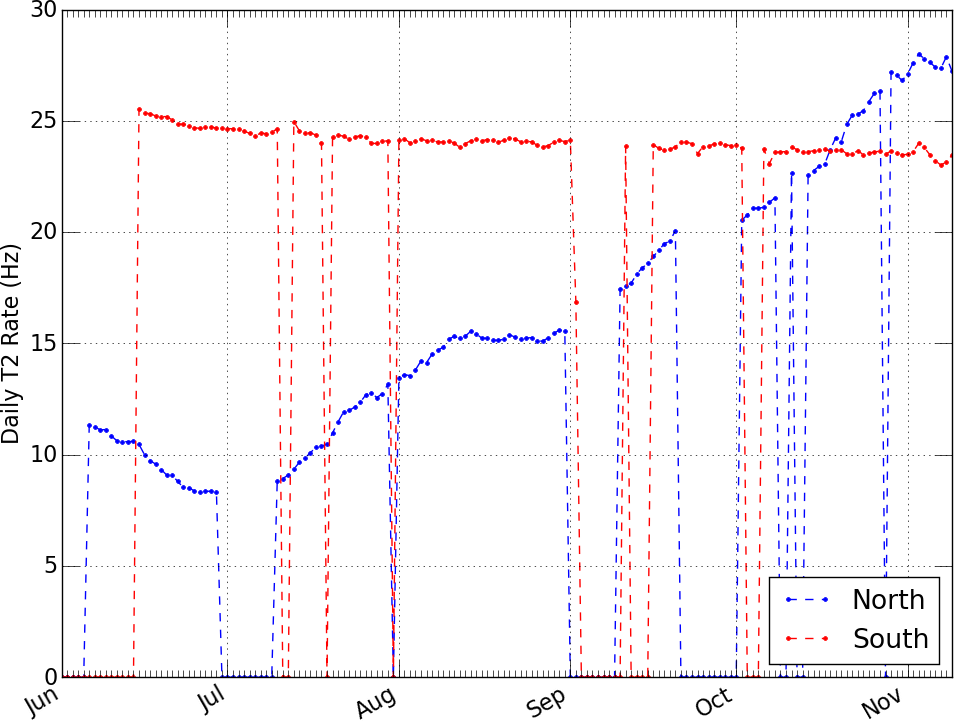Intro
The Telescope Array (TA), in Delta, Utah, is an international collaboration studying Ultra-High Energy Cosmic Rays in the Northern Hemisphere. TA has the same goals and objectives as The Pierre Auger Observatory, but monitors a different portion of the sky, and utilizes encased scintillator panels as their surface detectors.
Since 2014 members HEA and TA have begun a collaborative effort to directly compare Northern Hemisphere data with Southern Hemisphere data. This involves deploying several Pierre Auger type, water-Cherenkov detectors inside the TA array, and configuring them so that they record the same extensive air showers. This will allow for a direct comparison of data taken by the two different surface detectors and enable researchers to calibrate past data from the two observatories to improve our analysis.
Pierre Auger at TA also serves as a test site for proposed hardware to be used in upgrades of The Pierre Auger Observatory in Malargue, Argentina. Structural elements for the Beyond 2015 upgrade have been installed on the Pierre Auger SDs in the TA array to test their field durability, and weatherproofing.
Installation at TA CLF
The first stationed installed (summer 2014) at the Central Laser Facility (CLF) was a prototype Auger North station. Although the exterior tank design is similar, north stations use a single PMT and are controlled with updated electronics. The tank was lowered into position, filled with water, calibrated, and wired to an Auger computer in the CLF. After about 9 months of operation, we returned to the CLF to install the Auger south station, “Cosmo.” Both stations have been collecting shower data since June 2015.

In September of 2015 we revisited the CLF to install the sctinalltor box that will make its debut as part of the Auger Prime upgrade. The hardware was assembled in Utah and mounted on Cosmo.
Data acquisition
Normally, Auger stations transmit data wirelessly. Since our stations are proximal to the CLF, and since we don't have the power requirements for a large computer system to run the suite of DAQ programs that are online in the south, we instead made a wired connection to a small computer (SBC) inside the CLF. The wired connections use Ethernet, RS232 and CAN to communicate with the stations. The SBC is running a stripped down version of the central system used in Argentina, along with a newer program which handles the north station.
The SBC is connected to Telescope Array's LAN, which is used for daily data dumps to a TA server. This server is accessible via the Internet.
Current status
Since the south station has been online we've been collecting T2 data. The T2 is a station level trigger formed by coincidences between the PMTs. Cosmo transmits a list of time stamped T2 events at a rate of 1 Hz to the SBC, which is read out by our software.
The north station has also been collecting T2 data which is sent to the SBC via Ethernet. Additionally, this station has been configured to dump all its event data onto local storage, which is then transferred to a TA server every day. This amounts to roughly 15-25 GB worth of PMT trace data.

The north and south stations form a doublet separated by roughly 1.5m. This separation is ideal for studying low energy showers, however, the event rate is too high to analyze coincidences between these tanks in real time to form a T3 (physics) trigger needed for the south station. In the future we hope to address this by piping a TA global array trigger directly to the SBC.
Local trigger
In the interim while the TA global trigger is being prepared, we are working on deploying a small muon detector, farther from the doublet, which can be used to trigger the tanks for higher energy showers.
The detector will use a 3-fold coincidence circuit and time stamp events using an FPGA based time tagging system developed at CWRU. The SBC will analyze T2 lists generated by the north and south tanks, along with the muon detector, and then issue physics triggers if events occur within a window.
Joint trigger
